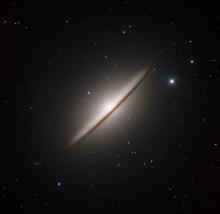Listen to today's episode of StarDate on the web the same day it airs in high-quality streaming audio without any extra ads or announcements. Choose a $8 one-month pass, or listen every day for a year for just $30.
You are here
Blazars
The universe is filled with brilliant black holes. They shine like beacons, visible from billions of light-years away. And they fire “particle beams” toward Earth — jets of hot gas moving at almost the speed of light. They’re called “blazars.”
These supermassive black holes inhabit the cores of galaxies. And just to be clear, it’s not the black holes themselves that are bright. Black holes are completely dark — they emit no light of any kind.
But a black hole’s gravity pulls in gas, dust, and stars. The material spirals around the black hole at high speed, forming a disk. Friction in the disk heats it to millions of degrees, so it shines brighter than entire galaxies of stars.
So far, that description also fits another class of objects, known as quasars. What sets a blazar apart is a jet of super-heated gas, known as plasma, shooting away from the poles of the black hole.
Heat inside the disk rips atoms apart, giving the material an electric charge. Powerful magnetic fields in the disk scoop up some of the charged particles before they can disappear into the black hole. They shoot the particles into space at just below lightspeed. If one of the beams happens to aim toward Earth, it makes the object look especially bright — a blazar.
Astronomers have located thousands of them, with more joining the lineup all the time — bright black holes taking aim at Earth.
More about black holes tomorrow.
Script by Damond Benningfield





